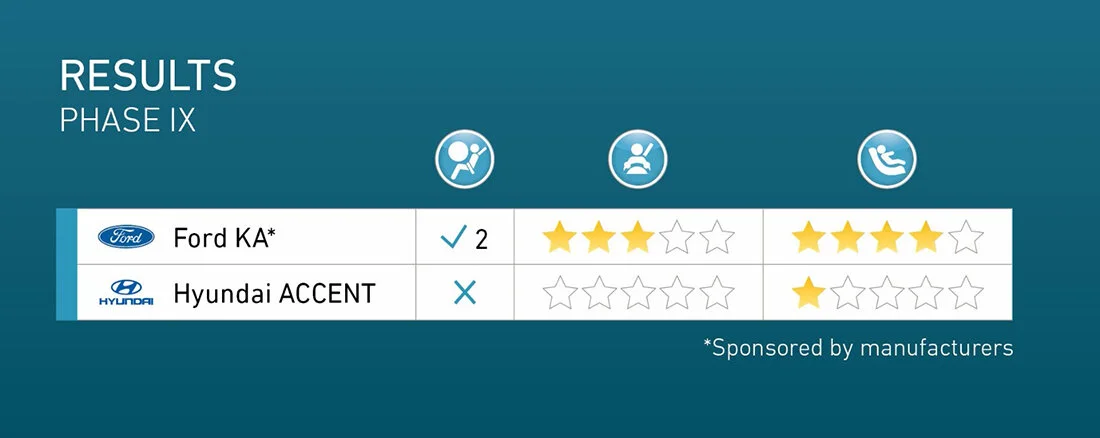Zero For Hyundai Accent While Ford Ka Improves Side Impact Protection
The fifth round of results for the New Car Assessment Programme for Latin America and the Caribbean, Latin NCAP, was released today with a poor result for the Hyundai Accent and an improvement for the Ford Ka’s side impact protection.
The Hyundai Accent, achieved zero stars for Adult Occupant Protection and one star for Child Occupant Protection.The Accent is available in its basic safety version without airbags. The impact of the head in the steering wheel and high chest compression in the driver, explain the low score in adult occupant protection despite a stable structure. The Accent does not offer ISOFIX anchorages and does not have 3 points belts in all seating positions. Moreover, the poor protection of the Q3 child dummy and a relevant amount of CRS that failed installation explain the one star result in child occupant protection. The side impact test of the Accent was not performed as the rating for the frontal test was already zero stars for adults. The Accent is a popular model for taxis in some countries of the pacific coast of Latin America and surprises with this low performance while Hyundai offers high levels of protection in markets like Europe in similar or even cheaper models.
The Ford Ka, produced in Brazil, achieved three stars for Adult Occupant Protection and four stars for Child Occupant Protection. The Ford Ka, which is produced in Brazil, was tested in 2017 with a disappointing zero star rating for adult occupant protection due to the poor side impact performance. Ford decided to improve the side impact protection of the KA and to sponsor a new assessment of the model in 2018. The Ka produced as from 12th June 2018 (as from VIN 9B9BFZH55U7K8206502) was improved with structural reinforcements for the side impact protection in the B-pillar and energy absorption elements for the side impact adult protection in the doors. The adult occupant protection just managed to achieve three stars showing weak protection for the chest of the adult in the side impact. The Child Occupant protection showed four star result with good protection for the frontal and side impact test for the three years old dummy and the 18 months old dummy both installed using ISOFIX and top tether and support leg respectively. The Ka still offers only lap belt in the rear centre seat in some versions.
Alejandro Furas, Secretary General of Latin NCAP said:
“It is encouraging to find more compact models like the Ka being improved; however its basic safety performance is still below the European version. It is alarming that relevant car manufacturers like Hyundai are still selling zero stars cars in Latin America while they offer standard five star safety as standard in similar models in Europe.
With these new results, Latin NCAP shows once again that the market together with consumers has forced the improvement of popular models earlier and ahead of local regulations that in the best case just started to include side impact protection for new models only. Unfortunately, local regulations still does not include Electronic Stability Control (ESC), pedestrian protection, meaning the region is still 20 years behind Europe, where already having ESC, and pedestrian protection in place is now legislating for Autonomous Emergency Braking (AEB).
Making independent crash test information available to consumers has become a very powerful and efficient tool that is already pushing Latin American market to safer cars. Governments should offer incentives, encourage and promote mandatory rating for all cars sold in their markets to speed up the process to help save lives. Governments should encourage and create incentives to cars with active safety technologies like ESC and AEB systems in order to shift the safety levels of new cars sold in the region and to line up with global requirements”
Ricardo Morales, Latin NCAP Chairman of the Board of Directors said:
“We receive with great enthusiasm the voluntary improvements of Ford as a reaction to a past poor performance Latin NCAP result, this clearly demonstrates how effective consumers testing programmes are in achieving road safety goals. This car model was improved earlier and beyond government requirements. We campaign to see more reactions like this in order to continue fighting the sale of zero and one star cars in our region. The double standards some manufacturers still have for Latin America and the Caribbean when compared with North America and Europe remains totally unacceptable”.
Ford Ka
Read the full crash test report
Watch the crash test video
Download crash test image
Hyundai Accent
Read the full crash test report
Watch the crash test video
Download crash test image
About Latin NCAP
The New Car Assessment Programme for Latin America and the Caribbean, Latin NCAP, was launched in 2010 to develop a regional system of independent crashworthiness and safety rating across Latin America and Caribbean (LAC). Latin NCAP replicates similar consumer testing programmes developed over the last thirty years in North America, Europe, Asia and Australia, and which have proved to be very effective in improving the safety of motor vehicles. Since 2010 Latin NCAP has published the results of more than one hundred cars in nine test phases.
Latin NCAP acknowledges the support received by the Global New Car Assessment Programme (Global NCAP), International Consumer Research and Testing (ICRT), FIA Foundation, the Inter-American Development Bank (IDB) and Bloomberg Philanthropies Global Road Safety Initiative.
Latin NCAP is an Associate member of Global NCAP and supports the United Nations Decade of Action for Road Safety 2011-2020 and the Stop the Crash Partnership.
More info: www.latinncap.com






